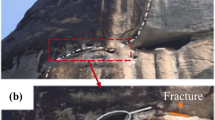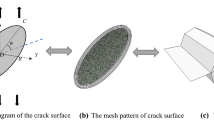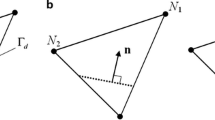Abstract
Rock is more sensitive to tensile loading than compressive loading, since the tensile strength of rock is much lower than compressive strength. The fracture characteristics of rock in the tensile state are of great significance to the understanding of rock failure mechanisms. To this end, we have conducted numerical simulation researches on mode I cracking process of rock with varying homogeneity, using the Realistic Failure Process Analysis program. With the increase of homogeneity, cracks are concentrating to the ligament area with a decreasing number of crack bifurcations, and the main crack path is becoming smooth. Crack behaviors and mechanical properties are influenced significantly when the homogeneity index is in the range of 1.5 to 5. When the homogeneity index is greater than 30, they are not affected by rock homogeneity and the rock can be considered as essentially homogeneous. It is considered that the global and local strengths are affected by the distribution of rock mechanical properties at mesoscale, which influence the crack behaviors and mechanical characteristics.
摘要
由于岩石的抗拉强度远低于其抗压强度,其对拉伸荷载比压缩荷载更加敏感。因此研究拉伸荷 载下岩石的断裂特性对于深入理解岩石的破坏机制具有重要意义。本研究中,作者利用岩石破坏过程 分析系统RFPA,对不同均质度岩石I型裂纹扩展过程展开了研究。随着岩石均质程度的提高,裂纹 逐渐向韧带区域集中,并且裂纹分叉逐渐减少,主裂纹趋于平滑。当均质度在1.5~5 区间内,岩石裂 纹行为和力学性能受均质度的影响比较严重。当均质度大于30 时,二者基本不受均质度差异的影响, 此时岩石可基本上认为是均质材料。细观尺度上岩石力学性质分布影响了岩石整体和局部强度,进而 影响了裂纹行为。
Similar content being viewed by others
References
GONG Feng-qiang, LUO Song, YAN Jing-yi. Energy storage and dissipation evolution process and characteristics of marble in three tension-type failure tests [J]. Rock Mechanics and Rock Engineering, 2018, 51(11): 3613–3624. DOI: https://doi.org/10.1007/s00603-018-1564-4.
GONG Feng-qiang, WU Chen. Identifying crack compaction and crack damage stress thresholds of rock using load-unload response ratio (LURR) theory [J]. Rock Mechanics and Rock Engineering, 2020, 53(2): 943–954. DOI: https://doi.org/10.1007/s00603-019-01936-z.
ZUO Jian-ping, LIU Hui-hai, LI Hong-tao. A theoretical derivation of the Hoek-Brown failure criterion for rock materials [J]. Journal of Rock Mechanics and Geotechnical Engineering, 2015, 7(4): 361–366. DOI: https://doi.org/10.1016/j.jrmge.2015.03.008.
ZUO Jian-ping, LI Hong-tao, XIE He-ping, JU Yang, PENG Su-ping. A nonlinear strength criterion for rock-like materials based on fracture mechanics [J]. International Journal of Rock Mechanics and Mining Sciences, 2008, 45(4): 594–599. DOI: https://doi.org/10.1016/j.ijrmms.2007.05.010.
CHEN Bin, XIANG Jian-sheng, LATHAM J P, BAKKER R R. Grain-scale failure mechanism of porous sandstone: An experimental and numerical FDEM study of the Brazilian Tensile Strength test using CT-Scan microstructure [J]. International Journal of Rock Mechanics and Mining Sciences, 2020, 132: 104348. DOI: https://doi.org/10.1016/J.IJRMMS.2020.104348.
LIU Guang, CAI Ming, HUANG Ming. Mechanical properties of brittle rock governed by micro-geometric heterogeneity [J]. Computers and Geotechnics, 2018, 104: 358–372. DOI: https://doi.org/10.1016/j.compgeo.2017.11.013.
LIU Tao-ying, ZHANG Chao-yang, CAO Ping, ZHOU Ke-ping. Freeze-thaw damage evolution of fractured rock mass using nuclear magnetic resonance technology [J]. Cold Regions Science and Technology, 2020, 170: 102951. DOI: https://doi.org/10.1016/j.coldregions.2019.102951.
TAN Xin, KONIETZKY H, CHEN Wei. Numerical simulation of heterogeneous rock using discrete element model based on digital image processing [J]. Rock Mechanics and Rock Engineering, 2016, 49(12): 4957–4964. DOI: https://doi.org/10.1007/s00603-016-1030-0.
ZUO Jian-ping, WANG Jin-tao, SUN Yun-jiang, CHEN Yan, JIANG Guang-hui, LI Yan-hong. Effects of thermal treatment on fracture characteristics of granite from Beishan, a possible high-level radioactive waste disposal site in China [J]. Engineering Fracture Mechanics, 2017, 182: 425–437. DOI: https://doi.org/10.1016/j.engfracmech.2017.04.043.
ZUO Jian-ping, XIE He-ping, DAI Feng, JU Yang. Three-point bending test investigation of the fracture behavior of siltstone after thermal treatment [J]. International Journal of Rock Mechanics and Mining Sciences, 2014, 70: 133–143. DOI: https://doi.org/10.1016/j.ijrmms.2014.04.005.
TANG Chun-an, HUDSON A J. Rock failure mechanisms: illustrated and explained [M]. Boca Raton: CRC Press, 2010. DOI: https://doi.org/10.1201/b10997.
XU Ying, YAO Wei, XIA Kai-wen. Numerical study on tensile failures of heterogeneous rocks [J]. Journal of Rock Mechanics and Geotechnical Engineering, 2020, 12(1): 50–58. DOI: https://doi.org/10.1016/j.jrmge.2019.10.002.
LAN Heng-xing, MARTIN C D, HU Bo. Effect of heterogeneity of brittle rock on micromechanical extensile behavior during compression loading [J]. Journal of Geophysical Research, 2010, 115(B1). DOI: https://doi.org/10.1029/2009JB006496.
CHEN Hong-ran, XUE Lei. Numerical investigation on progressive fracture behaviours of macroscopic heterogeneous rock bridge [J]. European Journal of Environmental and Civil Engineering, 2020, 24(5): 603–619. DOI: https://doi.org/10.1080/19648189.2017.1410728.
GARDNER R, PIAZOLO S, EVANS L, DACZKO N. Patterns of strain localization in heterogeneous, polycrystalline rocks-A numerical perspective [J]. Earth and Planetary Science Letters, 2017, 463: 253–265. DOI: https://doi.org/10.1016/j.epsl.2017.01.039.
RADIOTI G, CERFONTAINE B, CHARLIER R, NGUYEN F. Experimental and numerical investigation of a long-duration thermal response test: Borehole heat exchanger behaviour and thermal plume in the heterogeneous rock mass [J]. Geothermics, 2018, 71: 245–258. DOI: https://doi.org/10.1016/j.geothermics.2017.10.001.
LI Ang, SHAO Guo-jian, SU Jin-bo, SUN Yang, YU Tian-tang, SHI Hou-gai. Influence of heterogeneity on mechanical and acoustic emission behaviours of stratified rock specimens [J]. European Journal of Environmental and Civil Engineering, 2018, 22(sup1): s381–s414. DOI: https://doi.org/10.1080/19648189.2017.1373709.
KARIMPOULI S, FARAJI A, BALCEWICZ M, SAENGER E H. Computing heterogeneous core sample velocity using Digital Rock Physics: A multiscale approach [J]. Computers & Geosciences, 2020, 135: 104378. DOI: https://doi.org/10.1016/J.CAGEO.2019.104378.
TANG C A, THAM L G, WANG S H, LIU H, LI W H. A numerical study of the influence of heterogeneity on the strength characterization of rock under uniaxial tension [J]. Mechanics of Materials, 2007, 39(4): 326–339. DOI:https://doi.org/10.1016/j.mechmat.2006.05.006.
ULUSAY R. The ISRM suggested methods for rock characterization, testing and monitoring: 2007–2014 [M]. Cham: Springer, 2014. DOI: https://doi.org/10.1007/978-3-319-07713-0.
ZHU W C, TANG C A. Micromechanical model for simulating the fracture process of rock [J]. Rock Mechanics and Rock Engineering, 2004, 37(1): 25–56. DOI: https://doi.org/10.1007/s00603-003-0014-z.
HUANG M L, WONG R H C, WANG S Y, TANG C A, JAIO R M. Numerical studies of the influence of heterogeneity on rock failure with pre-existing crack in uniaxial compression [J]. Key Engineering Materials, 2004, 261–263: 1557–1562. DOI: https://doi.org/10.4028/www.scientific.net/KEM.261-263.1557.
TANG C A, LIU H, LEE P K K, TSUI Y, THAM L G. Numerical studies of the influence of microstructure on rock failure in uniaxial compression-Part I: Effect of heterogeneity [J]. International Journal of Rock Mechanics and Mining Sciences, 2000, 37(4): 555–569. DOI: https://doi.org/10.1016/S1365-1609(99)00121-5.
ZHANG Shi-chao, MA Tian-hui, TANG Chun’an, JIA Peng. Microseismic monitoring and experimental study on mechanism of delayed rockburst in deep-buried tunnels [J]. Rock Mechanics and Rock Engineering, 2020, 53(6): 2771–2788. DOI: https://doi.org/10.1007/S00603-020-02069-4.
CHEN Tie-lin, LI Chao, ZHANG Ding-li. A numerical simulation of effects of softening and heterogeneity on the stress intensity factor of quasi-brittle material [J]. Advances in Mechanical Engineering, 2015, 6: 586472. DOI: https://doi.org/10.1155/2014/586472.
ZUO Jian-ping, LU Jing-fang, GHANDRIZ, R, WANG Jin-tao, LI Yan-hong, ZHANG Xiao-yan, LI Jun, LI Hong-tao. Mesoscale fracture behavior of Longmaxi outcrop shale with different bedding angles: Experimental and numerical investigations [J]. Journal of Rock Mechanics and Geotechnical Engineering, 2020, 12(2): 297–309. DOI: https://doi.org/10.1016/j.jrmge.2019.11.001.
YONG Rui, YE Jun, LI Bo, DU Shi-gui. Determining the maximum sampling interval in rock joint roughness measurements using Fourier series [J]. International Journal of Rock Mechanics and Mining Sciences, 2018, 101: 78–88. DOI: https://doi.org/10.1016/j.ijrmms.2017.11.008.
ATKINSON B K. Subcritical crack growth in geological materials [J]. Journal of Geophysical Research: Solid Earth, 1984, 89(B6): 4077–4114. DOI: https://doi.org/10.1029/JB089iB06p04077.
VOLKOV G S, SOPENKO S I. A method of the complex evaluation of the crack resistance of rock in the stage of subcritical crack growth [J]. Strength of Materials, 1987, 19(10): 1352–1358. DOI: https://doi.org/10.1007/BF01523234.
HAO Rui-qing, LI Jiang-teng, CAO Ping, LIU Bo, LIAO Jun. Test of subcritical crack growth and fracture toughness under water-rock interaction in three types of rocks [J]. Journal of Central South University, 2015, 22(2): 662–668. DOI: https://doi.org/10.1007/s11771-015-2568-9.
ZUO Jian-ping, LI Yu-lin, ZHANG Xiao-yan, ZHAO Zhi-hong, WANG Ting-zheng. The effects of thermal treatments on the subcritical crack growth of Pingdingshan sandstone at elevated high temperatures [J]. Rock Mechanics and Rock Engineering, 2018, 51(11): 3439–3454. DOI: https://doi.org/10.1007/s00603-018-1527-9.
NARA Y, KOIKE K, YONEDA T, KANEKO K. Relation between subcritical crack growth behavior and crack paths in granite [J]. International Journal of Rock Mechanics and Mining Sciences, 2006, 43(8): 1256–1261. DOI: https://doi.org/10.1016/j.ijrmms.2006.03.016.
MUNZ D, FETT T. Subcritical crack growth [C]// Ceramics: Mechanical Properties, Failure Behaviour, Materials Selection. Berlin: Springer Berlin Heidelberg, 1999: 77–108. DOI: https://doi.org/10.1007/978-3-642-58407-75.
ZEHNDER A T. Fracture mechanics [M]. Dordrecht: Springer, 2012. DOI: https://doi.org/10.1007/978-94-007-2595-9.
TADA H, PARIS P C, IRWIN G R. The stress analysis of cracks handbook [M]. New York: ASME Press, 2000. DOI: https://doi.org/10.1115/1.801535.
YANG Ji-yun, ZHANG Xing. Mathematical research on the relation between resistance curve of crack growth and residual strength [J]. Journal of Mechanical Strength, 2003, 25(3): 334–339. http://www.jxqd.cbpt.cnki.net/WKE/WebPublication/paperDigest.aspx?paperID=8a030f39-14fc-48d4-84d5-f028db6b3e7c. (in Chinese)
LIU Chuan-cheng, ZHANG Qiang-yong, XIANG Wen, ZHOU Xin-yu. Experimental study on characteristics and mechanism of macrography and mesoscopic failure of deep granite from beishan [J]. Geotechnical and Geological Engineering, 2020, 38: 3815–3830. DOI: https://doi.org/10.1007/s10706-020-01260-2.
HASHIBA K, FUKUI K. Effect of water on the deformation and failure of rock in uniaxial tension [J]. Rock Mechanics and Rock Engineering, 2015, 48(5): 1751–1761. DOI: https://doi.org/10.1007/s00603-014-0674-x.
LUO Rong, ZENG Ya-wu, CAO Yuan, LI Ling. Research on influence of inhomogeneity degree on mechanical parameters of inhomogeneous rock [J]. Rock and Soil Mechanics, 2012, 33(12): 3788–3794. http://ytlx.whrsm.ac.cn/CN/Y2012/V33/I12/3788. (in Chinese)
XU Shi-lang, REINHARDT H W. Determination of double-Determination of double-K criterion for crack propagation in quasi-brittle fracture Part I: experimental investigation of crack propagation [J]. International Journal of Fracture, 1999, 98(2): 111–149. DOI: https://doi.org/10.1023/A:1018668929989.
Author information
Authors and Affiliations
Contributions
WANG Jin-tao conducted the numerical simulation and wrote the first draft of the manuscript. ZUO Jian-ping provided the ideas and edited the draft of the manuscript.
Corresponding author
Additional information
Conflict of interest
WANG Jin-tao and ZUO Jian-ping declare that they have no conflict of interest.
Foundation item: Project(BJJWZYJH01201911413037) supported by the Beijing Outstanding Young Scientist Program, China; Projects(51622404, 41877257) supported by the National Natural Science Foundation of China; Project (2018SMHKJ-A-J-03) supported by Shaanxi Coal Group Key Project, China
Rights and permissions
About this article
Cite this article
Wang, Jt., Zuo, Jp. Numerical simulation on effect of heterogeneity on mode I fracture characteristics of rock. J. Cent. South Univ. Technol. 27, 3063–3077 (2020). https://doi.org/10.1007/s11771-020-4529-1
Received:
Accepted:
Published:
Issue Date:
DOI: https://doi.org/10.1007/s11771-020-4529-1




